The Work of Jan Jacobsen |
This article first appeared in |
| Written by: Gerhard Fromm, München, Germany | Issue 57 - June 1999 |
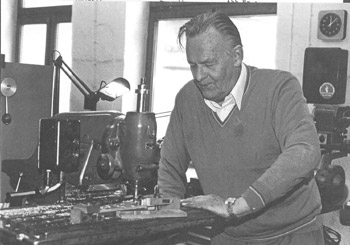 Jan Jacobsen in his machine shop in Munich, Germany.
Picture supplied by Gerhard Fromm. Jan Jacobsen in his machine shop in Munich, Germany.
Picture supplied by Gerhard Fromm.Jan Jacobsen died June 23, 1998 following cancer surgery in a hospital in Augsburg, Germany. The name Jan Jacobsen was well known in the movie industry. Through his expertise with cameras, lenses, sound equipment, front projection equipment and other pieces of film apparatus he built himself an everlasting monument. • Go to Obituary - Jan Jacobsen • Go to Jan Jacobsen - His Story He was born in Norway in December 1916. As a teenager he was fascinated by the movies. He assembled his first 9,5mm camera with simple tools when he was just 16 years of age. Jan Jacobsen went to college in Hannover, Germany, to study radio + communication. He graduated with a diploma in spite of the fact that he spent much time in his own workshop building a 16mm single system with optical sound. During college he heard about and met Dr. Curt Stille who was working on improving magnetic sound. With a combination of college and practical knowledge he returned to Oslo, Norway, where he, as a young engineer, built a mixing studio with magnetic sound. On top of that he also built a genuine "J.J." optical sound camera with which you could dub sound on sound. This installation was operated until the 60s. After the Second World War Jacobsen went to America. There was a curious story as told by Mr. Kenneth Richter. In those days Mr. Richter was running a shop near New York for collimators and cameras. One camera was the extremely small EMP 16mm (Envelope Minimum Possible). One day a slim young man entered the shop where Richter had been working. Under his arm he carried the shell of a bombsight apparatus from an old Lockheed bomber. Jan had decided to use the shell to build a camera and wanted to use the shop where Richter was working. During the day the machines were used to manufacture machines for the shop. They agreed Jacobsen could use the machines at night for a dollar an hour. No one believed the camera would work, but work it did and was later used for filming commercials. |
Further in 70mm reading: |
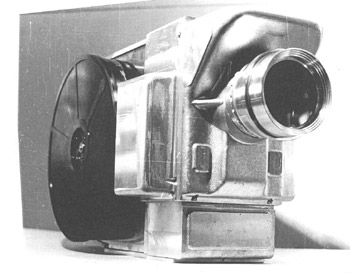 The unfinished Jan Jacobsen Technirama prototype
camera. Picture supplied by Gerhard Fromm. The unfinished Jan Jacobsen Technirama prototype
camera. Picture supplied by Gerhard Fromm.Back in Oslo, Jacobsen was assigned to build a new 35mm camera with magnetic sound for Swedish film productions. With his previous experience with magnetic sound he added a 17,5mm drive to a Bell & Howell studio camera. He also built an amplifier. The whole setup was bulky but it worked and was used for many years. In 1954 CinemaScope was introduced. The anamorphic lenses were rare and monopolized by 20th Century Fox. Jan received an invitation to go to London, the center of the European movie industry in those days. Jacobsen developed his own anamorphic lenses. The lenses were used under the names ScaniaScope, HammerScope and many more. The lenses were good and soon the company Arnold & Richter in Munich, Germany invited Jan to work for them. He developed a series of UltraScope anamorphic lenses. Despite some reluctance, Jacobsen also developed a series of wide-angle anamorphic lenses. In those days the anamorphic elements sat in the front of the basic lens. The wider the lens, the more distortion the lens had. Jacobsen´s idea was to put the anamorphic element behind the lens. The wide lens became a success and proved his concept sound. Equally simple was his idea to put the anamorphic element behind an existing zoom lens. This is the way the first anamorphic zoom was developed. The idea was so simple, yet no one before him thought of it. In 1959 Jacobsen started to develop the VarioScope system. Through tests carried out in England and in the USA, he wanted to introduce a large format (65/70mm) by which the format on the screen could change depending on the scene. A landscape would be very wide, but a picture of a person would be tall. The framing and stereo sound was to be controlled from a control track. The process was never really finished because of the complicated projection technique. |
|
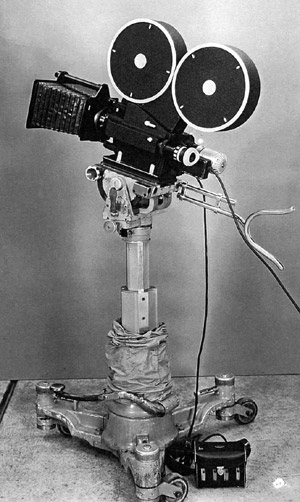 The very compact 5 perf 65mm "MCS" Modern
Cinema Systems Superpanorama 70 location camera by Jan Jacobsen. Picture
supplied by Gerhard Fromm. The very compact 5 perf 65mm "MCS" Modern
Cinema Systems Superpanorama 70 location camera by Jan Jacobsen. Picture
supplied by Gerhard Fromm.By coincidence the ambitous German cinema owner Mr. Engelbrecht of the Royal Palast cinema in Munich took notice of Jacobsen when he saw a demonstration of the VarioScope camera. He arranged a meeting between Jacobsen and the businessmen Mr. Travnicek and Mr. Pinelli. The gentlemen convinced Jacobsen to develop a European version of the highly successful Todd-AO process. So was the "MCS" (Modern Cinema System) founded. Jacobsen and his small team built 6x 65mm 5-perf field cameras in a very short time. The first film was "Flying Clipper" (1962). The camera worked perfectly. The VarioScope camera was also used during filming of "Flying Clipper". A side note is that one of the cameras fell overboard and is to this day sitting at the bottom of the Mediterranean. The MCS camera was also used on the filming of the Karl May movie "Old Shatterhand". Then followed "Der Kongress Amüsiert Sich" and "Uncle Tom's Cabin" for which Jacobsen built two additional 65mm blimped studio cameras. The death of Mr. Pinelli and Mr. Travnicek caused Modern Cinema Systems to close. The cameras were sold and to this day they are lost (The writer of this article would like to know the whereabouts of these cameras.). NASA used one of the MCS-70 Superpanorama field cameras for a number of years. In 1960 Jacobsen developed a Super Technirama camera with a rather unusual design. As with the Super Parvo camera, a 300-meter cassette is located on each side of the camera. The mirror reflex shutter is above the optics and the viewfinder has been moved to the rear of the camera. Only one specimen was built, and the present whereabouts is unknown. In 1963 he built a special very quiet and compact 65mm 5-perf camera for MGM Studios. The camera was built in Copenhagen, Denmark, where he borrowed a friends machine shop [Editors note: It was most likely Mr. Ernst Jacobsen's machine shop in Copenhagen, but this has been impossible to verify. The Danish Mr. Jacobsen is very ill and is presently not interested in being interviewed]. The MGM camera was very beautiful and probably one of the most elegant "J.J." cameras ever! |
|
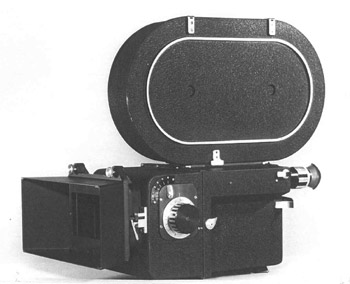 The J.J. 5 perf. 65mm camera Jan Jacobsen made for
MGM. Picture supplied by Gerhard Fromm. The J.J. 5 perf. 65mm camera Jan Jacobsen made for
MGM. Picture supplied by Gerhard Fromm.Jacobsen returned to Munich where two MCS-70 cameras had re-emerged. Mr. Engelbrecht, who had bought them, had a new idea for a 3D format. Jacobsen was excited and he rebuilt the 65mm cameras. He succeeded in putting two CinemaScope images side-by-side on 65mm film. Simultaneously he developed a projection lens capable of projecting both images with one projector. Several films were made utilizing this process, including "Operation Taifun" starring Alan Delon. The process was sold to a company in Switzerland, to be used for a system to shoot 30-minute 3D action ride-movies shown in dome shaped cinemas. The next assignment for Jacobsen was very special. In Toronto, Canada, a group of large screen enthusiasts had been working on a new large screen process. At EXPO 69 in Japan they had used 5 Arriflex cameras on a special rig to form a very large picture. The process had flaws, including color shifting and the join lines between the separate panels. They envisioned a new format in 15 perf. 65mm running horizontal like VistaVision. They called their system IMAX (Image Maximum). No camera manufacturer could supply such a camera. There was fear of problems with register pins and the oversized pull-cross claws. After all, the camera would consume nearly 2 meters of film per second. Jacobsen´s name was mentioned and he was brought to Toronto. Back home in Copenhagen he constructed the prototype IMAX camera in his friend's shop in a very short time. Jacobsen´s solution was a double set of pull-cross claws each moving 7,5 frames. With the IMAX camera ready, the new process was ready. Except for the one small problem: no projector was available! A regular projector with a Maltese cross movement would not last with the 15 perf. format. Jacobsen knew of Australian Ron Jones who had invented a new form of film transport, the Rolling Loop. The Toronto folks traveled to Australia and bought the patent. The IMAX system was now complete. Jacobsen´s next project was a two-level front projection system called DualScreen for which he later received an Academy Award. Harry Saltzman asked him to come to London to build front projection devices for several studios. He also buildt a special VistaVison set-up for one of the "Superman" movies. Concurrently with DualScreen in London he was working for Salzman on a Super 8 sound camera. The camera was never introduced on the market, however. |
|
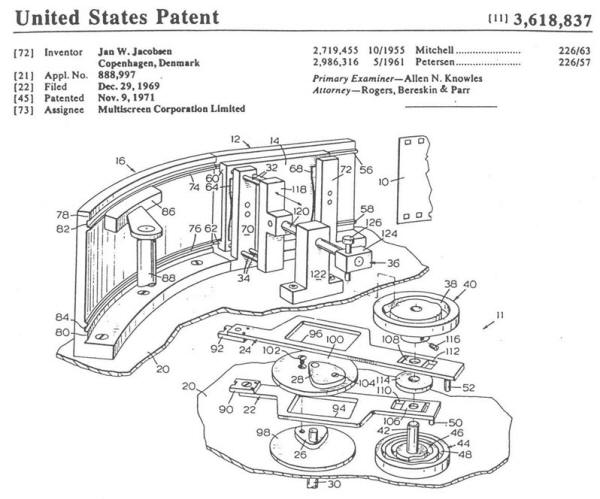 Drawing of Jacobsen's IMAX camera movement. Patent
filed December 29, 1969.
2x 7½ perf 15 perf movement
developed in Copenhagen, Denmark 1967-69 Drawing of Jacobsen's IMAX camera movement. Patent
filed December 29, 1969.
2x 7½ perf 15 perf movement
developed in Copenhagen, Denmark 1967-69In his basement back in Augsburg, Germany, Jacobsen buildt a few portable DualScreen set-ups which he sold to movie studios in Vienna and Munich. With DualScreen behind him, he attempted two new cameras, one 16mm and one 35mm, with a rolling loop movement instead of pull-down claws. These did not work out so well, however, and he gave up. He took the 35mm apart and rebuilt it (Most of the 16mm rolling loop camera body has been saved by the author of this article). During his later years Jan Jacobsen led a quiet and modest life in his house outside Augsburg, Germany, where he kept himself busy in his small machine shop with new ideas and inventions. One of these was an improved and faster pull-cross system to the VistaVision version of his DualScreen system. For his experiments he built another 8 perf. camera that subsequently turned up in Stockholm, Sweden. That second camera is in the camera collection of the author. |
|
Gerhard Fromm, author of this article |
|
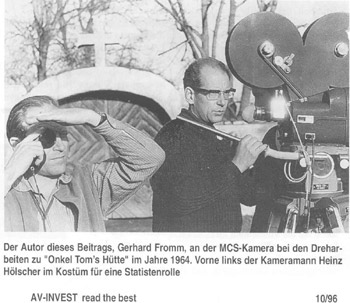 Gerhard
Fromm on
imdb.com Gerhard
Fromm on
imdb.comGERHARD FROMM, Munich; inventor, author of numerous technical publications and filmtechnique historian. He was a tremendous source of information about Jan W. Jacobsen. Assistant cameraman with the M.C.S. production "Uncle Toms Cabin". Owner of company „Filmtechnik Fromm“ and member of the B.V.K. By Christian Appelt, Germany |
|
|
Go: back
- top - back issues Updated 22-01-25 |
